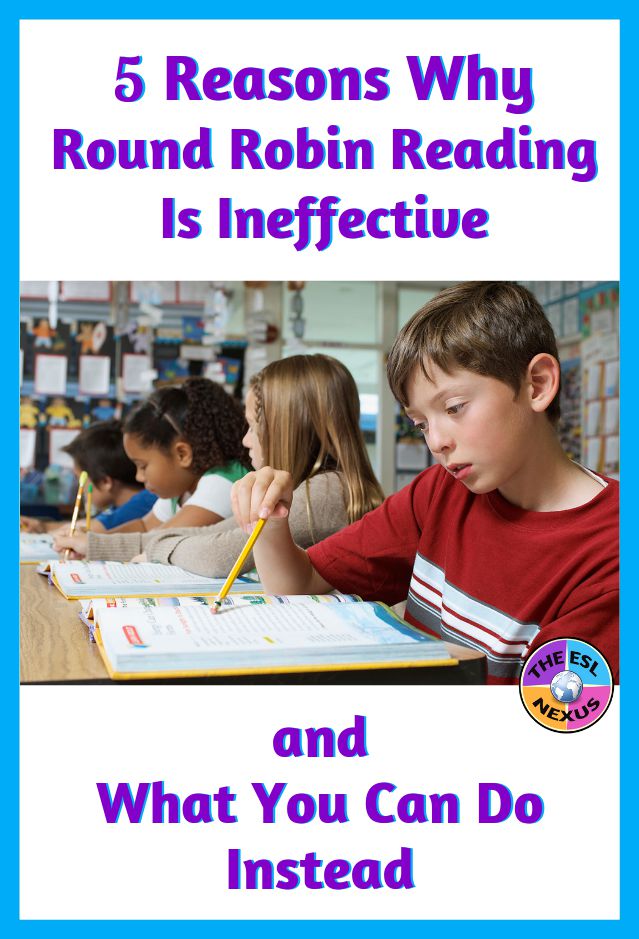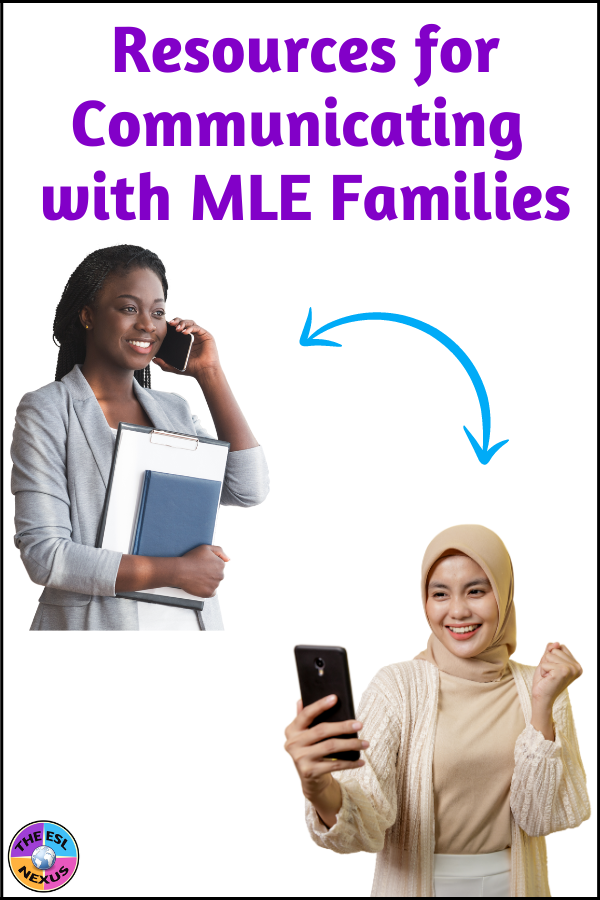Learning to read is important. So is understanding information that is read aloud. But it is not realistic to expect students to read a text out loud in class and simultaneously comprehend what was read. It doesn’t matter if they are the students doing the reading or they are just listening to another student reading. Round robin reading is an ineffective method of teaching reading and content to English Language Learners and native English speakers.
Reasons Why You Shouldn’t Do Round Robin Reading
* Reading out loud is a different skill from reading silently. A student can be an excellent reader when reading silently but stumble over words when forced to read aloud. When I was in school, I read several grade levels above my actual grade but I hated having to read out loud because I got nervous about having to perform in front of an audience. Just imagine how ELLs who are not fluent English speakers would feel in that situation! They are already self-conscious about their language skills so calling on them to read to the whole class would be nerve-wracking. And if a teacher skips over them but calls on every other student, that will also make ELLs self-conscious because they are being singled out for being different and/or less able than everyone else in the class.
* Students read at different rates: Some people read quickly and others more slowly. Asking students to listen and follow along in the book to someone who reads at a different speed makes it difficult to actually comprehend the material. If a student reads faster than someone else, the listener doesn’t have time to process the information that is heard and can’t keep up in the book. If a student reads slower than someone else, the listener can be tempted to read ahead but is lost when asked a question by the teacher because she was not in the right place. For ELLs whose reading skills are not as proficient as the other students, even following along in the textbook would be difficult since some, many, or most of the words would be unknown to them. ELLs with lower levels of language proficiency who are in mainstream classes might be lost from the first sentence.
* When students do round robin reading, they often ignore the punctuation because they can’t read ahead to know when a sentence ends and they can’t go back and reread it to get it right after they see the whole sentence. That means their intonation isn’t correct. That, in turn, exacerbates the difficulty for ELLs and other students in understanding the material.
* It’s virtually impossible to learn new content when also reading that content out loud in front of other people. If students are reading material that is new to them, they will inevitably end up focusing on trying to pronounce the words correctly. But new content means many new words, so the meaning gets lost because the form takes precedence. I did push-in ESL in a 5th grade Science class for a couple years and that teacher often had students do round robin reading. I sat next to an ELL with intermediate language proficiency and it was impossible for him to read even one paragraph in the science textbook out loud without making lots of errors. He didn’t learn anything because not only were the science concepts new to him, many of the words he was trying to read were new as well. Nor did the other students in the class learn anything when he read because it was new to them, too, and he had to stop so often for help with pronunciation that his listeners lost the gist of what he was reading.
* Some teachers use round robin reading to assess students’ pronunciation skills, thinking that if students can pronounce words accurately that means they understand their meaning. But just because students can say words correctly, that doesn’t mean they understand what they are saying. And what is the point of reading unless it is to comprehend what is being read? For ELLs, especially those at beginning and intermediate levels of language proficiency, the vagaries of English spelling make it difficult for them to know how to pronounce unknown words. Asking them to do a cold reading and expecting them to do it well is unfair and not realistic.
 |
| ELLs & other students don’t benefit from round robin reading; source: The ESL Nexus |
What You Can Do Instead of Round Robin Reading:
* If you are doing round robin reading because you are reading a class novel, put the students in small groups of mixed ability and have them read the novel that way. Reading in a small group is much less intimidating for ELLs. You can do the same thing with textbooks.
* If you are doing round robin reading because you are introducing new content material to your class, such as the case with the Science teacher mentioned above, you can read the text yourself. As the teacher, you are already familiar with the content and will be able to read it with proper intonation and pronunciation, which facilitates comprehension by all students. Students can follow along in the book if you wish and see how words that are new to them are pronounced.
* If you are doing round robin reading because you want to ask questions about specific parts of the material to see how well students understand it, create a worksheet or other activity instead that asks the questions you’re interested in. Then have your students complete it after reading the material on their own or in pairs or small groups. Let students work together to do the worksheet or activity. Not only does that give students the chance to explain the information to their classmates, it also gives them speaking practice. Graphic organizers can also help students better understand the material; I have a free printable version HERE and a paid digital version HERE that helps students practice different kinds of reading strategies.
* If you are doing round robin reading to assess students’ pronunciation skills, do the assessment individually and in private so students aren’t put on the spot and don’t get nervous.
Another Suggestion:
When you, the teacher, read out loud from a book, give students the option of following along in the text or just listening while you read. Many teachers want their students to follow along as they read but for ELLs, often it is more productive for them to just listen to the material being read. Because ELLs are not fluent in English, they may recognize words when they hear them but not know how to spell them and therefore not recognize them when encountered in a text. If understanding the content is your aim, then letting students listen as you read will be more effective. Later, on their own, you can have the ELLs read the text and, since they have already heard it, it will be easier for them to comprehend the material.
Book Recommendations:
Mainstream teachers in middle and high school, and many ESL teachers, are not necessarily literacy specialists but are often tasked with teaching reading. Many of them have not been trained in how to teach students to read or, if they have, they have not been trained to teach second language learners how to read, which is somewhat different from teaching native speakers to read. Below are 2 books I have found especially helpful for teaching reading to ELLs.
(This post contains affiliate links. That means if you purchase one or both books below, I make a small commission but it’s at no additional cost to you. Thank you for your support!)
From Reader to Reading Teacher

This book contains background theory about reading and practical ideas for teaching reading to ELLs. See my detailed review HERE.
Reading and Writing in More Than One Language

This short book is aimed at K-12 teachers and includes lots of classroom examples about teaching literacy skills to ELLs. You can find my detailed review HERE.
Conclusion
There are many effective ways to teach students to read. Round robin reading is not one of them. As the new school year in the U.S. gets underway, I sincerely hope that you will not use round robin reading in your classes.




